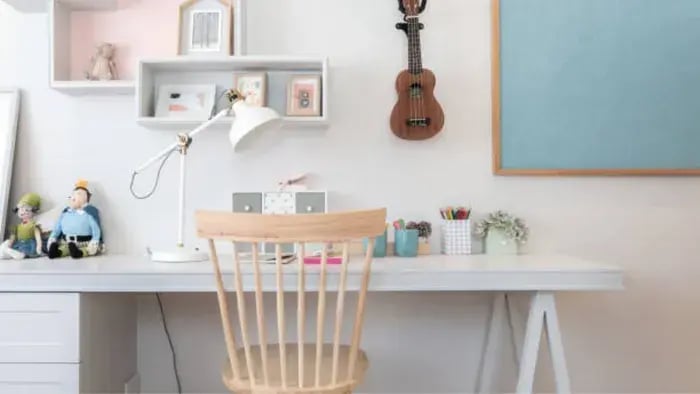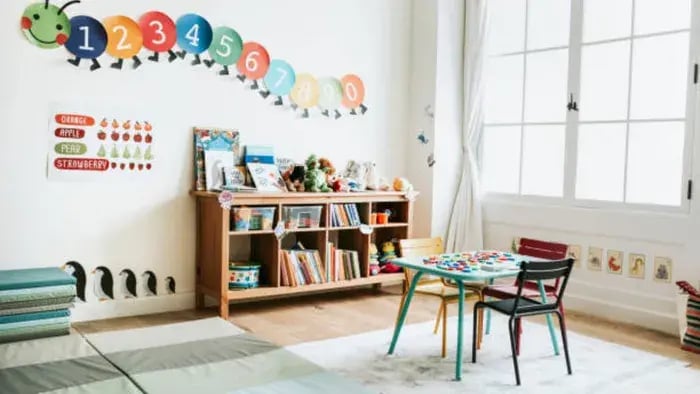- Theme-Based Corners
- Minimal Desk, Maximum Focus
- Color Zones for Mood Boost
- Custom Study Wall
- Personal Achievement Shelf
- Multi-Lighting Setup
- Movement-Friendly Layout
- Quiet Storage Nooks
- Nature-Inspired Touches
Introduction

A study room becomes meaningful when it supports clear thinking and calm energy. It doesn’t need to be filled with designer pieces or the latest décor trends. What matters more is how the space makes you feel, focused, relaxed, and ready to learn. The right atmosphere can help children concentrate better, allow teens to stay motivated through long study hours, and give parents a place to guide or work alongside their kids.
Sometimes, a simple change like adding a pinboard, a plant near the window, or soft lighting can turn a regular corner into a more inviting study spot. Kids enjoy spaces that feel playful yet organized. Tweens may need a setup that reflects their growing independence. Teens often want personal touches that match their style. No matter the age, a well-thought-out space can support better habits and boost confidence.
The ideas ahead are for anyone looking to make study time feel less like a task and more like a daily rhythm that flows with comfort and clarity.
9 Study Room Decoration Ideas for Creative and Productive Spaces

A study room should feel like a personal zone where focus comes naturally and distractions feel far away. It's about creating a space that supports thinking clearly, feeling calm, and staying motivated. Below are thoughtful ideas that balance function with personality, making study time more enjoyable and productive.
Theme-Based Corners
Give the space a gentle theme, like nature, travel, space, or books. This creates visual interest without overstimulating the mind. A globe, map wallpaper, or bookshelf shaped like a tree can spark imagination. For younger kids, a jungle or sky-themed wall adds a sense of wonder. For teens, subtle patterns or textured panels add maturity without being dull.
Minimal Desk, Maximum Focus
Go for a desk that has just enough space for study essentials, nothing more. Limit clutter by using storage boxes under the desk and organizing stationery in small trays or stands. The less that’s on the table, the easier it is to think clearly. A neutral-toned surface (wood, white, grey) allows the focus to stay on books, not distractions.
Color Zones for Mood Boost
Instead of coloring the whole room brightly, assign soft color zones. Use calming tones like sky blue, lavender, or light peach for walls, and then add energizing accents like yellow or coral in a cushion, clock, or pencil holder. This layered color effect keeps the space cozy and cheerful without being overwhelming.
Custom Study Wall
Set up one wall just for study inspiration, stick removable chalk sheets or whiteboards for writing ideas, to-do lists, or quotes. Use magnetic boards for pinning project notes or charts. This interactive space becomes a part of the learning journey and grows with your child’s needs.
Personal Achievement Shelf
Install a floating shelf or small display rack to keep medals, drawings, or certificates. Seeing their own progress every day can silently boost motivation. This shelf should evolve with your child, making it a reflection of their learning story, not just their wins.
Multi-Lighting Setup
Use a combination of light sources to suit different times of the day. Overhead lights give general brightness, but a desk lamp with adjustable brightness helps during intense reading or writing. Add a small ambient light, like a lava lamp, a Himalayan salt lamp, or a soft LED strip, to set a relaxed mood during break time.
Movement-Friendly Layout
Give the room some breathing space; a wide layout allows for stretching, walking around while memorizing, or sitting in different postures. Consider adding a soft rug or a floor cushion where your child can shift when they need a change from the chair. Movement helps boost alertness and mental clarity.
Quiet Storage Nooks
Loud drawers and messy cupboards can ruin the peace. Choose silent-closing drawers or fabric organizers. Color-code bins or label small boxes for books, worksheets, or creative tools. When kids know exactly where things are, they can focus better and tidy up faster too.
Nature-Inspired Touches
Let the outdoors influence the indoors, a study table placed near a window with sheer curtains gives natural light and a bit of breeze. Add wooden frames, jute mats, or leafy prints for a grounding effect. A small potted plant or a fish bowl can create a natural pause in a hectic study day.
Conclusion

Study room decoration is about creating an environment that encourages calm thinking, comfortable sitting, and creative exploration. Whether it’s a small desk in the corner or an entire room, what matters is that it feels right for your child’s learning rhythm. A little thought in how it looks and feels can quietly inspire big learning moments.
Her love for storytelling began with reading her grandfather’s speeches, where Tarishi saw the power of words in creating lasting memories. Combining her passions for food and writing, she has turned her life into a fulfilling path of sharing stories that celebrate flavours and how food brings communities together.
The views expressed are that of the expert alone.
The information provided in this content is for informational purposes only and should not be considered a substitute for professional medical advice, diagnosis, or treatment. Always seek the advice of your physician or another qualified healthcare provider before making any significant changes to your diet, exercise, or medication routines.
















